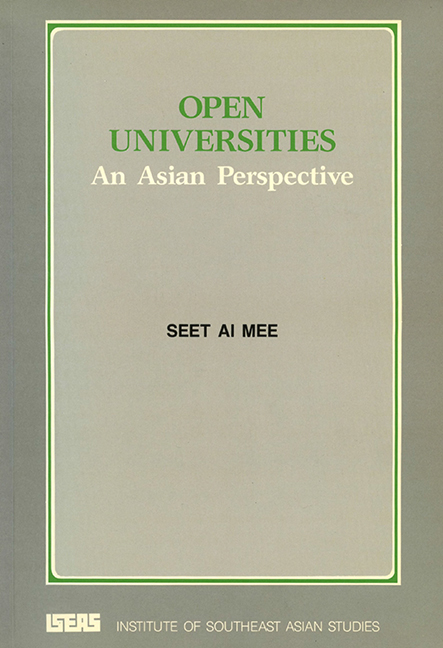Book contents
- Frontmatter
- Contents
- Acknowledgements
- I Introduction
- II Open Universities
- III The Quality of Distance Education
- IV Science and Technology Teaching
- V Continuing Professional Education
- VI Costs of Distance Education
- VII Concluding Remarks
- Notes
- Select Bibliography
- Abbreviations
- Member Institutions of the Association of Asian Open Universities
- THE AUTHOR
- Frontmatter
- Contents
- Acknowledgements
- I Introduction
- II Open Universities
- III The Quality of Distance Education
- IV Science and Technology Teaching
- V Continuing Professional Education
- VI Costs of Distance Education
- VII Concluding Remarks
- Notes
- Select Bibliography
- Abbreviations
- Member Institutions of the Association of Asian Open Universities
- THE AUTHOR
Summary
Today, it is recognized the world over and especially in Asia with its growing population that education has not only a social and moral function but is also an economic necessity. The education system generally provides limited access to the rural poor and other disadvantaged groups and to a certain extent, contributes to the inequalities in society. How does one provide wider access to education to the rural poor, to working adults, to women at home and to disadvantaged groups?
There is a growing perception that the schools and conventional universities cannot be the sole purveyors of knowledge and shapers of social attitudes and that mass communciations media such as radio and TV can play major roles in transmission of knowledge to large numbers of people. There are many reasons for looking into alternatives in education delivery especially for Asian countries. Good quality educational materials are not widely available. Human and financial resources are limited in many countries. There is not only increasing demand for education for city youths and working adults, but also a need to provide practical knowledge to rural youths and farmers for the development of related skills. Furthermore, among educational leaders and social and policy planners, there is a growing belief that despite quantitative gains in education in Asia, there has been a decline in its quality.
The Concept of Distance Education
The terms “distance education” and “open learning” have been used with a variety of different meanings. “Distance education” is best referred to as the educational process where a significant proportion of the teaching is conducted by someone, removed in space or time from the learner; and where programmes use a combination of educational media varying from print to audio to TV broadcasts, video recordings and computers and microprocessors. Opportunities for face-to-face study as well as learning from recorded materials are included. There is a rich and oft changing mix of media and meeting — this is what has been the strength of distance education programmes.
- Type
- Chapter
- Information
- Open UniversitiesAn Asian Perspective, pp. 1 - 4Publisher: ISEAS–Yusof Ishak InstitutePrint publication year: 1992

